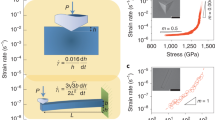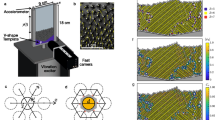Abstract
It has been suggested that a common conceptual framework known as ‘jamming’ (refs 1 and 2) may be used to classify a wide variety of physical systems; these include granular media3, colloidal suspensions4 and glass-forming liquids5, all of which display a critical slowdown in their dynamics before a sudden transition to an amorphous rigid state. Decreasing the relevant control parameter (such as temperature, drive or inverse density) may cause geometrical constraints to build up progressively and thus restrict the accessible part of the system's phase space. In glass-forming liquids (thermal molecular systems), jamming is provided by the classical vitrification process of supercooling, characterized by a rapidly increasing and apparently diverging viscosity at sufficiently low temperatures6,7. In driven (athermal) macroscopic systems, a similar slowdown has been predicted to occur, notably in sheared foam or vibrated granular media8,9. Here we report experimental evidence for dynamic behaviour, qualitatively analogous to supercooling, in a driven granular system of macroscopic millimetre-size particles. The granular medium is perturbed by isolated tapping or continuous vibration, with the perturbation intensity serving as a control parameter. We observe the random deflection of an immersed torsion oscillator that moves each time the grains rearrange, like a ‘thermometer’ sensing the granular noise10,11. We caution that our granular analogy to supercooling is based on similarities in the dynamical behaviour, rather than quantitative theory.
This is a preview of subscription content, access via your institution
Access options
Subscribe to this journal
Receive 51 print issues and online access
$199.00 per year
only $3.90 per issue
Buy this article
- Purchase on Springer Link
- Instant access to full article PDF
Prices may be subject to local taxes which are calculated during checkout



Similar content being viewed by others
References
Liu, A. J. & Nagel, S. R. Jamming is not just cool anymore. Nature 396, 21–22 (1998).
Liu, A. J. & Nagel, S. R. (eds) Jamming and Rheology: Constrained Dynamics on Microscopic and Macroscopic Scales (Taylor and Francis, New York, 2001).
Jaeger, H. M., Nagel, S. R. & Behringer, R. P. Granular solids, liquids, and gases. Rev. Mod. Phys. 68, 1259–1273 (1996).
Trappe, V., Prasad, V., Cipelletti, L., Segre, P. N. & Weitz, D. A. Jamming phase diagram for attractive particles. Nature 411, 772–775 (2001).
Tarjus, G. & Kivelson, D. in Jamming and Rheology: Constrained Dynamics on Microscopic and Macroscopic Scales (eds Liu, A. J. & Nagel, S. R.) 20–38 (Taylor and Francis, New York, 2001).
Angell, C. A. Formation of glasses from liquids and biopolymers. Science 267, 1924–1935 (1995).
Debenedetti, P. G. & Stillinger, F. H. Supercooled liquids and the glass transition. Nature 410, 259–267 (2001).
Langer, S. A. & Liu, A. J. Sheared foam as a supercooled liquid? Europhys. Lett. 49, 68–74 (2000).
O'Hern, C. S., Langer, S. A., Liu, A. J. & Nagel, S. R. Force distributions near jamming and glass transitions. Phys. Rev. Lett. 86, 111–114 (2001).
Kurchan, J. Emergence of macroscopic temperatures in systems that are not thermodynamical microscopically: towards a thermodynamical description of slow granular rheology. J. Phys. Condens. Matter 12, 6611–6617 (2000).
Barrat, A., Kurchan, J., Loreto, V. & Sellitto, M. Edwards' measures for powders and glasses. Phys. Rev. Lett. 85, 5034–5037 (2000).
Pak, H. K., Van Doorn, E. & Behringer, R. P. Effects of ambient gases on granular materials under vertical vibrations. Phys. Rev. Lett. 74, 4643–4646 (1995).
Bocquet, L., Charlaix, E., Ciliberto, S. & Crassous, J. Moisture-induced ageing in granular media and the kinetics of capillary condensation. Nature 396, 735–737 (1998).
D'Anna, G. Dissipative dynamics of granular media investigated by forced torsion pendulum. Europhys. Lett. 51, 293–299 (2000).
Nowak, E. R., Knight, J. B., Ben-Naim, E., Jaeger, H. M. & Nagel, S. R. Density fluctuations in vibrated granular materials. Phys. Rev. E 57, 1971–1982 (1998).
Risken, H. The Fokker-Planck Equation (Springer, Berlin, 1989).
D'Anna, G. & Gremaud, G. Activated-like hopping transition in weakly vibrated granular media. Europhys. Lett. 54, 599–604 (2001).
Berthier, L., Cugliandolo, L. F. & Iguain, J. L. Glassy systems under time-dependent driving forces: Application to slow granular rheology. Phys. Rev. E 63, 051302-1–051302-15 (2001).
Speedy, R. J. The hard sphere glass transition. Mol. Phys. 95, 169–178 (1998).
Acknowledgements
We thank P. Martin, A. Barrat, L. Cugliandolo and J. Kurchan for discussions and comments.
Author information
Authors and Affiliations
Corresponding author
Rights and permissions
About this article
Cite this article
D'Anna, G., Gremaud, G. The jamming route to the glass state in weakly perturbed granular media. Nature 413, 407–409 (2001). https://doi.org/10.1038/35096540
Received:
Accepted:
Issue Date:
DOI: https://doi.org/10.1038/35096540
This article is cited by
-
From solid-like to floating: evolution of dense granular cluster in dissipation behavior
Granular Matter (2024)
-
Dissipation Behaviors of Vibrated Granular Balls in Different Gravity Environments
Microgravity Science and Technology (2024)
-
Numerical modelling of granular flows: a reality check
Computational Particle Mechanics (2016)
-
A thermodynamic unification of jamming
Nature Physics (2008)
Comments
By submitting a comment you agree to abide by our Terms and Community Guidelines. If you find something abusive or that does not comply with our terms or guidelines please flag it as inappropriate.



